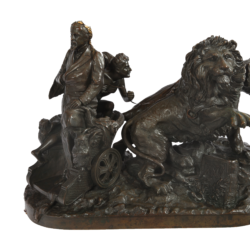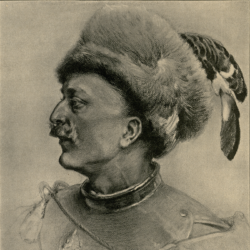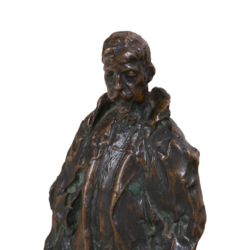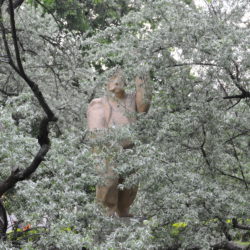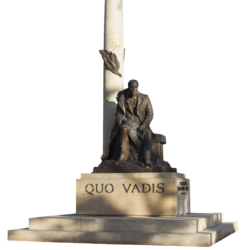
Ursus
The advancement of Ursus as a name is the most striking spatial evidence of the popularity of Henryk Sienkiewicz’s prose writing in the early 20th century. The eponym of Warsaw’s Ursus district is a character of Quo Vadis: A Narrative of the Time of Nero. This fact is emphasized in all historical studies on the Ursus Factory. Founded in 1893 in Warsaw’s Sienna Street under a different name, it changed its trademark specifically to include the famous appellation over a decade later.[1] The association between the fictional strongman and heavy-duty vehicles and engines that were produced in the factory proved catchy, and the company started to be commonly referred to as Ursus. This popular choice was sanctioned in 1954 by the official adoption of the “Ursus” name after the factory moved to Czechowice (today’s Ursus district). It is not a surprise, then, that Ursus had considerably more places with Sienkiewicz-related names (including the Trilogy characters, Zagłoba and Wołodyjowski [Volodyovski]) than could be expected of its rather small locality. The working-class settlement of Czechowice lost its autonomy after the anti-communist strikes of 1976 and was incorporated into Warsaw, which entailed the necessity to rename most of its streets to avoid reiteration. Among the most interesting examples that escaped this fate were Tadeusz Kościuszko and Zagłoba streets.[2] Putting Kościuszko’s case aside, Zagłoba, as opposed to e.g. Wołodyjowski (the title hero of the third part of the Trilogy), was not then present in the nomenclature of Warsaw streets. Paradoxically, this was a result of his earlier popularity as an eponymous character. The 1916 incorporation of suburbs into Warsaw and further additions in the interwar period and after WWII necessitated onomastic tricks of the highest order.[3] As early as the first year of the “great incorporation” – which, incidentally, was the year of Sienkiewicz’s death – Zagłoba was given his own street: an extension of Sokołowska beyond the local overpass and Górczewska Street in the district of Koło (the possible reason for this location could have been the fact that, on these very grounds, nobility elected Michał Korybut Wiśniowiecki, the son of Jeremi Michał Korybut Wiśniowiecki [Prince Yeremi], to be the King of Poland in 1669, and Zagłoba’s participation in the event was represented in the Trilogy). Following further expansions, in 1951, Warsaw had four separate Zagłoba Streets.[4] After the reorganization necessitated by the urban sprawl, though, it turned out that just one Zagłoba Street had survived – only to be demolished at the beginning of the 1970s to make space for the long and wide October Revolution Avenue (aleja Rewolucji Październikowej, today’s aleja Prymasa Tysiąclecia). It was due to these circumstances that Zagłoba Street in Ursus could be preserved in 1977. However, for the same reasons, Zagłoba failed to have a street named after him after the post-war incorporation of Służew into Warsaw, unlike other Trilogy characters: Kmicic [Kmita], Podbipięta [Podbipyenta], Skrzetuski [Skshetuski], Wołodyjowski [Volodyovsky], Wiśniowiecki (in 1951, however, the street of Jeremi Michał Korybut Wiśniowiecki [Prince Yeremi] – a representative of aristocracy, much maligned by the communist regime – was renamed Niedźwiedzia; ten years later, female heroine Oleńka was allegedly honored, though there is no conclusive evidence supporting the claim that such a street actually existed in Służew).[5]
Przypisy
- J. Domżalski, “Związki Ursusa z Warszawą” [On Ursus and Warsaw], in Śladami nazw miejskich Warszawy (z prac Zespołu Nazewnictwa Miejskiego Warszawy) [On proper names of places in Warsaw], Warsaw 2012, pp. 85–86.
- Ibidem, pp. 87–88.
- J. Zieliński, “Nazewnictwo okresu wielkiej inkorporacji, straty w lokalnych systemach nazewniczych na przełomie XIX i XX w.,” ibidem, pp. 39–56.
- J. Sawicki (ed.), “Nazwy występujące wielokrotnie w latach 1901–2010,” ibidem, p. 381; by comparison, there were only two Kmicic streets at that time (ibidem, pp. 331–332).
- J. Sawicki, “Nazwy w nowym Katalogu ulic m. st. Warszawy,” ibidem, pp. 227–228, 240–241; K. Handke, Słownik nazewnictwa Warszawy, Warsaw 1998, p. 380.

